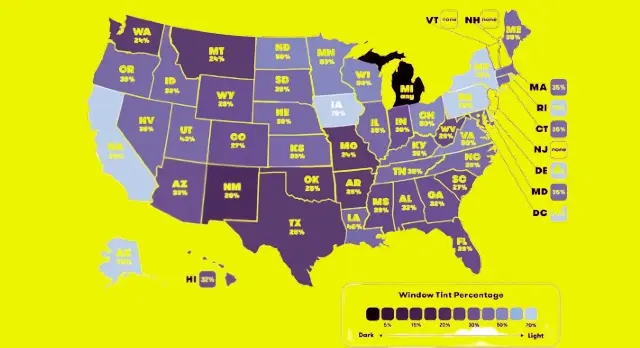When it comes to window tinting, regulations can vary from state to state within the United States. Understanding the window tinting laws is crucial to ensure compliance and avoid legal issues. In this article, we will provide you with a comprehensive guide to window tinting laws in the USA. Whether you’re a car owner, driver, or simply curious about the regulations, this article will equip you with the knowledge you need.

Understanding Window Tinting Laws
Window tinting laws govern the darkness or reflectivity of the tint applied to vehicle windows. These laws aim to ensure driver visibility, passenger safety, and law enforcement transparency. While some states have specific regulations, others may refer to standards like Visible Light Transmission (VLT), which measures the percentage of light allowed through the tint.
The Importance of Window Tinting Laws
Window tinting laws serve multiple purposes. They promote road safety by ensuring proper visibility for drivers, prevent potential criminal activities by maintaining transparency, and protect occupants from excessive heat and harmful UV rays. Adhering to these laws is essential to avoid penalties, fines, or even vehicle inspection failures.
Overview of Window Tinting Laws by State
Each state in the USA has its own set of window tinting laws. It’s important to note that these regulations can change over time, so it’s advisable to double-check with local authorities or the Department of Motor Vehicles (DMV) for the most up-to-date information. Here’s a brief overview of the window tinting laws in some states:
- Alabama
- Alaska
- Arizona
- Arkansas
- California
- Colorado
- Connecticut
- Delaware
- Florida
- Georgia
- Hawaii
- Idaho
- Illinois
- Indiana
- Iowa
- Kansas
- Kentucky
- Louisiana
- Maine
- Maryland
- Massachusetts
- Michigan
- Minnesota
- Mississippi
- Missouri
- Montana
- Nebraska
- Nevada
- New Hampshire
- New Jersey
- New Mexico
- New York
- North Carolina
- North Dakota
- Ohio
- Oklahoma
- Oregon
- Pennsylvania
- Rhode Island
- South Carolina
- South Dakota
- Tennessee
- Texas
- Utah
- Vermont
- Virginia
- Washington
- West Virginia
- Wisconsin
- Wyoming
Common Window Tinting Regulations
While regulations vary, there are some common aspects to consider:
Visible Light Transmission (VLT)
VLT refers to the percentage of light allowed through the tinted window. Most states have specific requirements for VLT, usually ranging from 20% to 70%. The lower the VLT percentage, the darker the tint.
Tint Darkness
Tint darkness is determined by the amount of light blocked by the window film. Some states specify darkness limits for different windows, such as the front windshield, front side windows, back side windows, and rear window. Make sure to understand the darkness limits for each window to comply with the regulations.
Reflectivity
Reflectivity refers to the ability of the tint to reflect incoming light. Excessive reflectivity can be distracting for drivers and others on the road. Many states prohibit or limit the use of highly reflective tints to maintain road safety.
Exemptions and Special Circumstances
Certain states provide exemptions or special circumstances for window tinting. These may include medical exemptions, allowances for commercial vehicles, or specific rules for classic or antique cars. It’s important to familiarize yourself with these exceptions to ensure compliance.
Consequences of Non-Compliance
Failure to comply with window tinting laws can result in consequences such as traffic stops, fines, penalties, and even vehicle inspection failures. Additionally, non-compliant tinting may need to be removed or modified to meet the legal requirements.
Conclusion
Understanding window tinting laws is crucial for every vehicle owner and driver in the USA. By complying with these regulations, you ensure your safety, avoid penalties, and enjoy the benefits of window tinting. Remember to research the specific laws in your state and consult with local authorities or the DMV for the most accurate and up-to-date information. Drive safely and confidently with a clear understanding of window tinting laws in the USA.
Note: This article provides general information and should not be considered legal advice. Always consult with local authorities or the DMV for the most accurate and current window tinting laws in your state.
Key Takeaways
- Window tinting laws in the USA vary from state to state and may include regulations regarding visible light transmission (VLT), tint darkness, reflectivity, and exemptions.
- Understanding and complying with window tinting laws is important to avoid penalties, fines, and potential vehicle inspection failures.
- Window tinting offers benefits such as UV protection, heat reduction, glare reduction, and enhanced privacy.
- When choosing window tinting, research local laws, select a reputable installer, consider your needs, check for warranty and quality, and seek professional advice.
- Stay informed and up-to-date on window tinting laws by consulting with local authorities or the Department of Motor Vehicles (DMV) in your state.
